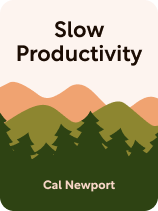

This article is an excerpt from the Shortform book guide to "Slow Productivity" by Cal Newport. Shortform has the world's best summaries and analyses of books you should be reading.
Like this article? Sign up for a free trial here.
Are you feeling overwhelmed and burned out at work? Do you want to increase your productivity while reducing stress?
Cal Newport argues that doing less at work can lead to greater accomplishments and improved well-being. By focusing on fewer, high-impact tasks, you can achieve better results and avoid burnout. This approach challenges the common belief that being busier means being more productive.
Keep reading for Cal Newport’s three-part advice on how to do less at work.
Do Less at Work
The first principle of slow productivity is to do less. Newport argues that, to truly excel and foster both creativity and quality in your work, you need to do fewer things. This principle challenges the common belief that being busier leads to greater accomplishments. In his book, Newport advocates for an alternative, sharing his advice for how to do less at work. He says you should dedicate your time, energy, and focus to a select few tasks that matter the most. By focusing on fewer tasks, you improve your concentration and are more likely to achieve better results.
(Shortform note: The advice to “do less” is widely supported by productivity experts, though opinions vary on the ideal number of tasks to focus on. For example, Gary Keller, author of The One Thing, insists that you should concentrate on the single most important task and allow other tasks to be adjusted or deferred accordingly. However, J.D. Meier, author of Getting Results the Agile Way, suggests that at the beginning of each day and the beginning of each week, you should write down three things you want to accomplish. These three things should be significant tasks that have a big impact on your work and life, but are also doable within the designated time period.)
Newport writes that doing less allows you to channel your resources more efficiently toward activities that genuinely contribute to your goals and personal fulfillment. Also, you can avoid the pitfalls of lower-quality work and burnout by embracing the idea of doing less.
| How to Negotiate Your Workload Communicating the value of doing less to your supervisor in a work environment that equates busyness with productivity can be challenging. However, by following this structured approach, you can effectively negotiate a more manageable workload. • Start with self-assessment, evaluating which tasks are essential and which can be streamlined or eliminated. • Prepare your case with evidence showing that reducing your workload can lead to better overall results and higher productivity. • Suggest practical solutions such as delegating tasks, outsourcing, or improving processes. • Emphasize the benefits for both you and the organization, including higher quality work, improved team morale, and a lower risk of burnout. • Additionally, bolster your argument with success stories from other companies that have benefited from a “less is more” approach. |
Newport says that every major project you take on comes with a cascade of smaller tasks, from emails to meetings, and all of them continue to eat away at your focus and time. Therefore, to successfully start doing less, you must take on fewer big projects. (Shortform note: Research backs Newport’s assertion that small tasks like meetings and email can eat away at your focus and time. According to the McKinsey Global Institute, workers spend an average of 28% of their time managing email, while meetings demand even more time. A study by the National Statistics Council found that over 37% of employee time is spent in meetings, many of which don’t contribute to meaningful progress on big-picture goals.)
Focus on Fewer Big Projects
Step one of doing less: Cut down on the big stuff. This means choosing a few important projects or goals to focus on and not overloading your plate with too many big commitments. Keep it simple so you can give those tasks your full attention. Newport provides the example of mathematician Andrew Wiles, who spent years focusing solely on proving Fermat’s Last Theorem (a number theory that had stumped mathematicians for centuries), ultimately achieving a groundbreaking result due to his concentrated effort.
| What to Consider When Determining Which Projects to Take On Wiles was a young boy when Fermat’s Last Theorem captured his attention, leading him to a career in mathematics. Unlike Wiles, many of us might not have a clear objective of proving a centuries-old theorem, and it may be hard to know which projects are the right projects to take on. In Setting the Table, restaurateur Danny Meyer outlines the factors he considers when deciding if a new project is a good fit. First, Meyer evaluates alignment with company values and culture. He also assesses market demand to identify gaps and opportunities where his venture can offer something unique. Financial feasibility is also crucial; Meyer advocates spending time on a detailed analysis of costs, potential returns, and overall financial health. Additionally, Meyer places significant importance on having the right team and talent to execute the project effectively. If he doesn’t have the team to do it well, it’s not the right project. Finally, he considers the broader impact on the community, prioritizing projects that contribute positively, such as job creation and fostering a sense of community. |
To ensure that you only take on what you have the capacity for, Newport suggests you establish a clear system for deciding whether you’ll take a project on and, if so, when it’ll be done—the aim is clarity about when things can realistically get started based on what else is happening.
(Shortform note: Only saying yes to some projects also means saying no to others. Greg McKeown, author of Essentialism, offers advice on how to say no gracefully. First, alleviate any guilt by separating the decision from the person; rejecting a request isn’t rejecting the person who made it. Next, communicate your decision with kindness. For example, you can say, “I’d love to help, but I’m overcommitted right now.” Finally, be clear. A definitive no is more respectful than a noncommittal “I’ll try.”)
Streamline Your Smaller Tasks
Once you have fewer projects to focus on, the next step is to streamline the smaller tasks that come with those big projects. Newport suggests the following strategies: First, automate routine activities to save time. For example, setting up email filters and auto-responses can help you manage and prioritize your inbox efficiently. Additionally, you can create more space in your schedule by investing in tools like project management software to organize and track your tasks or outsourcing lower-level tasks whenever possible.
(Shortform note: There’s an increasing number of AI-driven tools that can help you optimize how you manage smaller tasks. For example, Motion is an AI scheduler that automates your calendar planning by organizing tasks and meetings to optimize your productivity. However, while these tools promise increased efficiency, they also run the risk of becoming new sources of distraction. The key is to select tools that align with your needs, providing relief from menial tasks without adding to your cognitive load. For instance, you might find that a simple digital Pomodoro timer boosts productivity more than an elaborate task-tracking system.)
Be Strategic About What You Take On
Newport emphasizes that not all small tasks are equally important. He suggests having two lists—one where new ideas or tasks go (“Holding Tank”) and one for things you’re working on now (“Active List”). This way, instead of jumping to another task every time something new comes up, you can assess your current load and decide when—or if—you can tackle something new.
(Shortform note: The Eisenhower Matrix is another method for prioritizing smaller tasks. It sorts tasks into four quadrants: 1) Urgent and Important tasks that demand immediate action, 2) Important but Not Urgent tasks that are important but can be scheduled for later, 3) Urgent but Not Important tasks that are better delegated, and 4) Neither Urgent nor Important tasks that should be eliminated. This system clearly differentiates tasks, helping you to focus immediately on what truly matters, plan for the future, delegate wisely, and minimize time-wasters, thereby enhancing your productivity.)
Putting these strategies into practice helps control the chaos by ensuring you handle both large goals and daily responsibilities more effectively, allowing you to be less busy but more productive.

———End of Preview———
Like what you just read? Read the rest of the world's best book summary and analysis of Cal Newport's "Slow Productivity" at Shortform.
Here's what you'll find in our full Slow Productivity summary:
- The flaws with the traditional definitions of productivity
- The principles of Cal Newport’s “slow productivity”
- Why doing less actually means you’re doing more






